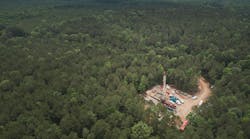Oil and gas companies have said it. Industry trade groups have said it. The record supports them.
In much of public consciousness and government policy-making, however, this message somehow remains obscure: It is possible to drill for and produce oil and gas without spoiling nature.
In fact, exploration and production occur all the time, all over the world, with environmental effects diminishing because of technology and heightened concern within the industry. Accidents are rare. Despite the improvements, environmentalists and like-minded policy-makers still proclaim nature's need to be protected against industry operations.
Now, however, the message emerges from a surprising source: the US Department of Energy.
Technology and environment
DOE has released an advance copy of a thick brochure from its Office of Natural Gas and Petroleum Technology entitled, "Environmental Benefits of Advanced Oil and Gas Exploration and Production Technology." Citing 30 years of "dramatic advances" in upstream technology, the foreword notes that "public awareness of the significant and impressive environmental benefits from new exploration and production technology advances remains limited." Then this: "We believe it is important to tell this remarkable story of environmental progress in E&P technology."
The brochure tells the story in more than 150 snazzy pages that, among other things, trace the history of industry technological development and catalog technologies ranging from downhole oil-water separation to 4D seismic operations.
An accompanying press release reports these highlights:
- If nothing had changed, four wells now would be required in the US to produce the oil that two wells produced in 1985. Thanks to improved oil field technology, one US well now handles 1985-level output.
- Increased well productivity avoids production of as much as 148 million bbl/year of drilling waste.
- Surface areas covered by well pads have shrunk by as much as 70%.
- Modular rigs and slimhole techniques enable operators to reduce the areas they need to clear for drilling operations by as much as 75% in comparison with conventional technology.
- Explosives are giving way to less-intrusive sources of sonic energy in seismic work.
The brochure even relates the improvements to continued growth in consumption of oil and gas. In a notable departure from conventional government practice, it wastes no space fretting over this unlamentable fact of modern human life.
DOE's message conflicts deliciously with the environmentalist orthodoxy of an administration populated with the likes of Vice-Pres. Al Gore, Environmental Protection Agency Administrator Carol Browner, and Interior Sec. Bruce Babbitt. Was there a security breach? With threats to natural values subject to such question, how is Babbitt, for example, supposed to defend federal-land management that confines oil and gas leasing to regions with existing production?
Reasonable context
Whatever the palace intrigue, DOE has performed a service by placing upstream oil and gas work in an environmental context more reasonable than the menacing one to which it is normally assigned. Producers will find the brochure gratifying. They might even want to share copies with perennial doubters. If the brochure proves difficult to find, interested parties should check either of two places: the DOE Department of Fossil Energy web site at www.fe.doe.gov or storage rooms at Interior and EPA. Hidden hoards might well develop at agencies with agendas subject to damage from widespread distribution of DOE's work.
Producers should, of course, welcome DOE's expression of support. But they also should recognize that it gives them no reason to relax. Nothing in the DOE document changes the producing industry's standard for environmental performance, which remains zero tolerance for error.

